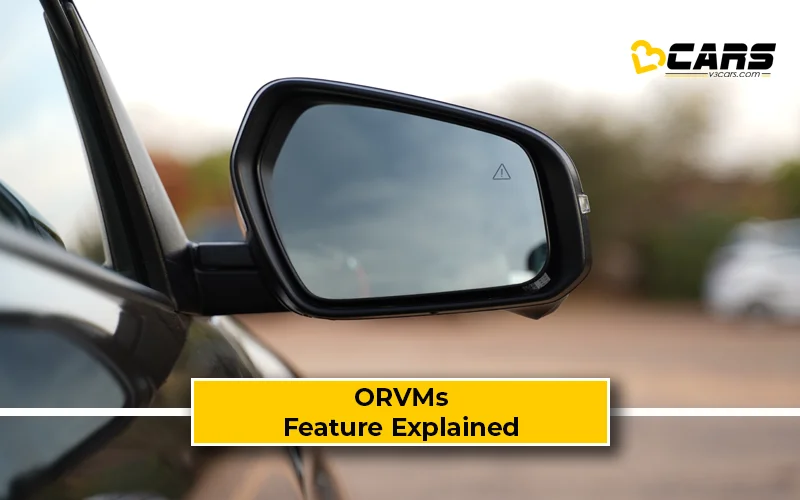What Are ORVMs Or Outside Rearview Mirrors? Feature Explained
In this Feature Explained article, we’ll present the most detailed analysis of the ORVMs or outside rearview mirrors in your car. We’ll list out the pros and cons, explain how it works, provide the typical cost of getting a ORVMs from the aftermarket, and repair and replacement costs of an ORVM power door mirror. Based on this analysis, we’ll suggest if you should add this feature to your car or skip it.

What Is An ORVM?
ORVMs or outside rearview mirrors are mirrors mounted on the exterior of your car, typically on the A-pillar (the pillar between the windshield and the front door). The mirrored surface reflects traffic and objects behind and beside your car, allowing you to see what's in your blind spots and change lanes or reverse safely.
How Does An ORVM Work?
There are different types of ORVMs based on how they are adjusted. They work as follows:
Types Of ORVMs:
- Aspherical ORVMs: These curved mirrors offer a wider field of view, reducing blind spots compared to flat ORVMs. They often have a distinct segmented design.
- Convex ORVMs: These mirrors have a wider viewing angle but tend to distort objects, making it difficult to judge distances accurately. Their use is not as common on modern cars.
- Heated ORVMs: These mirrors come with a built-in heating element that can defrost or de-mist the mirror surface in cold or wet weather, ensuring clear visibility in all conditions.
- Power-folding ORVMs: These electronically controlled ORVMs can be folded inwards with the press of a button, protecting them from damage in tight parking spaces or narrow car washes.
- Electrically Adjustable ORVMs: These ORVMs allow the driver to adjust the mirror's angle using electric motors controlled from inside the vehicle, providing precise and convenient adjustments.
- Auto-Folding ORVMs: These ORVMs automatically fold inwards when the vehicle is locked, and unfold when the vehicle is unlocked or started, providing added convenience and protection.
Blind-spot monitoring ORVMs: These advanced ORVMs incorporate integrated lights or warning systems that alert you to vehicles approaching from your blind spot.
Also Read: Power Mirrors - Detailed Feature Explained
What Are The Pros And Cons Of ORVMs?
Here are the pros of ORVMs:
- Enhanced safety: ORVMs provide a crucial view of your blind spots, reducing the risk of accidents while changing lanes or reversing.
- Improved visibility: ORVMs help you stay aware of your surroundings, allowing you to react quickly to potential hazards.
- Easy to use: Manually adjustable ORVMs are simple to operate, even for new drivers.
- Cost-effective: ORVMs are a relatively inexpensive component compared to other car features.
Here are the cons of ORVMs:
- Limited blind spot coverage: ORVMs might not eliminate all blind spots, especially for wider vehicles or vehicles with large pillars.
- Manual adjustment can be inconvenient: Manually adjustable ORVMs can be a hassle, especially while driving.
- Susceptible to damage: ORVMs are exposed and can be damaged in car washes, parking mishaps, or vandalism.
Also Read: Inside Rear View Mirror (IRVM) - Feature Explained
What Is The Cost Of Repairing Or Replacing A Broken ORVM?
The cost of repairing or replacing a broken ORVM depends on the severity of the damage:
- Broken mirror glass: Replacing a broken mirror glass is generally inexpensive, typically ranging from Rs. 200 to Rs. 500.
- Damaged housing: A cracked or broken ORVM housing can be more expensive to replace, costing anywhere from Rs. 1,000 to Rs. 3,000 depending on the car model and features like integrated turn signals or blind-spot monitoring.
- Malfunctioning electrics: If the electric adjustment mechanism in a power-folding ORVM fails, repairs can be expensive, potentially costing several thousand rupees depending on the diagnosis and parts required.
How Easy Is It To Install Aftermarket ORVMs In Your Car?
Looking to upgrade your car with features like power folding ORVMs or blind-spot monitoring? Aftermarket ORVMs that offer these features are widely available, but installation can be complex and require electrical wiring expertise. Here are some things to consider:
- Compatibility: Ensure the aftermarket ORVM is compatible with your car model's mounting points and electrical system.
- Legality: Some aftermarket ORVMs with features like twinkly or colourful lights might not be road-legal in India. Check local regulations before installation.
- Professional installation: Improper installation can damage your car's electrical system or compromise the functionality of the ORVM. Consider consulting a professional mechanic for safe and proper installation.
In India, most car manufacturers, even in affordable segments like A and B1, now offer power-adjustable ORVMs at least in their higher variants. While not essential for every driver, ORVMs are undeniably a safety feature worth considering, especially for those seeking a more convenient driving experience.
Note: Check your Car EMI with our - Car Loan EMI Calculator
You can use our Fuel Cost Calculator to see how much any petrol, diesel or CNG car will cost to run based on the latest fuel price in your city.


0 Comments